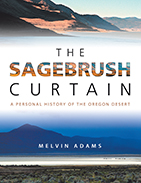
 |
Born in the Oregon desert in 1941, Adams has crafted a captivating book of his time there, a genuine and nostalgic revisiting of a treasure trove of never-ending adventures and discovery. While it is natural to be pained when leaving the land where you grew up, the author’s utilization of stunning images and evocative imagery paints a portrait of a land with an aura of haunting serenity. Adams’ trip down memory lane features a quartet of hunting, camping, fishing, and survival skills in Boy Scouts that highlighted his childhood. Audiences can surely envision the buckaroo country child dueling imaginary foes in an attempt to channel his inner Gene Autry, Roy Rogers, or the Long Ranger.
Nature’s prowess and majesty are undeniable as the haunting serenity, the calm of the day, gives way to the unbridled life that surfaces in the desert nights. Whether it is a petroglyph at Long Lake, a Frederic Remington sculpture, or Albert Lake, Adams portrays each with such precision that it comes alive. Better yet, the author’s knack for connecting facets of his beloved desert to anything from literary and biblical references to Salvador Dali’s “Persistence of Memory” is sure to help create an instant rapport between his readers and his paradise.
Some places never truly let you go. For Adams, the Lost Forest, in all its desolation, is seemingly one such place—a place for peace and inner reflection. In one particular instance of astounding imagery, Adams describes the wind around the Lost Forest area as being so forceful that it essentially uproots the bones of an ancient time and bygone species, including, but not limited to, mammoths, camels, flamingos, pelicans, etc. Ultimately, Adams brings readers into his space and land through the written word and encourages audiences to discover their own place worthy of eternal exploration.